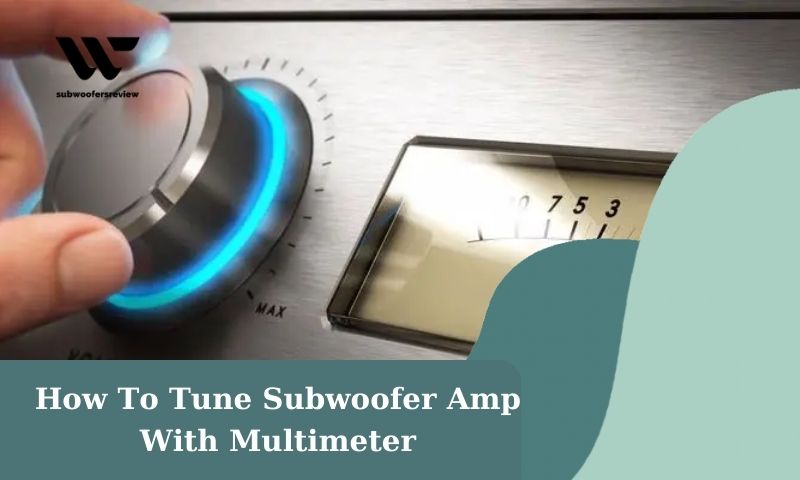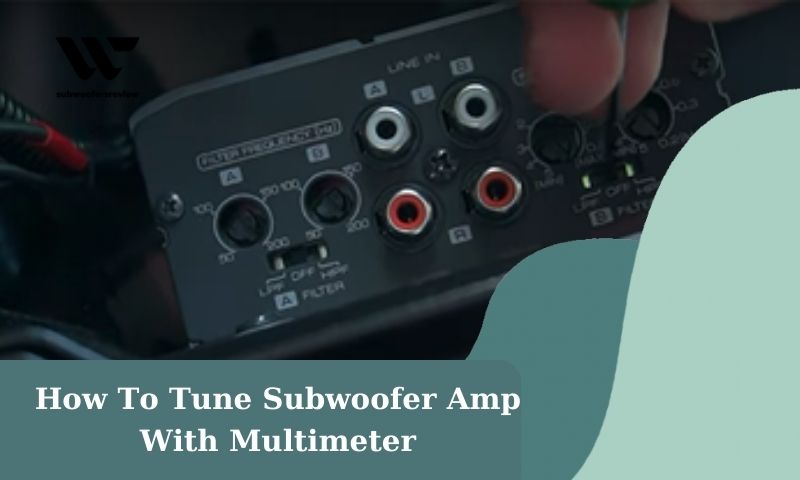How To Tune Subwoofer Amp With Multimeter? An excellent sound system enhances the power of music. By accurately tuning your amp with a multimeter, you can get the most out of your car entertainment and music system. It gives you outstanding sound quality while also safeguarding your devices.
By matching the input and output A.C. voltages of your amplifier, you can adjust its gain. This also avoids sound from clipping.
You need the following in order to adjust the gain controller:
A calculator, speakers, your amplifier’s instruction manual, a CD or flash drive with a test tone, and a digital multimeter. in this article subwoofersreview.com will discover detailed instructions on How To Tune Subwoofer Amp With Multimeter.
How To Tune Subwoofer Amp With Multimeter

Step 1: Use a multimeter to measure the speaker’s resistance.
See how resistant the speaker is. You’ll be utilizing a digital multimeter to connect to the amp. To do this, turn off the speaker’s power source. Then, identify the positive and negative terminals on the speaker. The positive end of the multimeter should have the red probe connected, and the negative terminal should have the black probe.
The ohm resistance displayed by the multimeter should be noted. Keep in mind that the maximum loudspeaker resistance is either 2, 4, 8, or 16 Ohms. So it is safe to note the value that is closest to the recorded value.
Step 2: Take note of the amp’s recommended output wattage
Find the suggested wattage output in the amplifier’s user manual. Contrast this with your speaker’s ohm resistance.
Step 3: Determine the necessary AC voltage
We now need to determine the amp’s target voltage. The gain of the amp needs to be set at this output voltage. The formula V = (P.R.), where P is the Wattage, R is the Resistance (Ohm), and V is the goal A.C. voltage, must be used to determine it.
Let’s say your manual specifies a 500 Watt amplifier, and you measured the speaker’s resistance with a multimeter to be 2 Ohms. 500 Watts must be multiplied by 2 Ohms to get 1000 in order to answer the equation. Now, using a calculator, compute the square root of 1000. Your output voltage, in the instance of a one gain control, should be 31.62 V.
If your amplifier has two gain controls, each one will be handled differently.
Utilize the power output of a single channel for your voltage calculation, for instance, if the amplifier has four channels and 200 Watts of power. The square root of 200 Watts times 2 Ohms is the voltage for each gain control.
Step 4: Disconnect all gadgets.
Remove all the extra cables from the amplifier you are testing, including the ones for the speakers and subwoofers. To remember the configuration for when you have to plug them back in, only unplug the positive terminals.
Step 5: Set the equalizer to zero.
You can either disable the equalization or set all of its parameters, including Bass Boost, Loudness, Treble, Bass, Processing, and equalization Functions, to 0. This keeps sound waves from being filtered, giving the bandwidth its widest possible range.
Step 6: Set gain to zero
The minimum setting for the majority of amplifiers can be obtained by fully counterclockwise rotating the dial.
The amplifier is only connected to the power source after completing steps 4, 5, and 6.
Step 7: Set the volume to 75%
Set the head unit’s volume to 75% of its maximum level. As a result, the stereo won’t transmit distorted audio to the amplifier.
Step 8: Play the test tone
Before continuing, double check that the speaker is unplugged from the amplifier.
To test your system, you are now in need of a test tune. Play a sine-wave test tone with a 0 dB volume on the stereo. For a subwoofer amp, the sound must have a wavelength of 50–60 Hz, and for a midrange amp, it must have a wavelength of 100 Hz. It can be produced by getting it from the internet or using an application like Audacity.
Configure the head unit so that the tone plays continually on loop.
Step 9: Connect the amplifier and multimeter.
Set the A.C. Volts setting on your digital multimeter, then select the voltage range where the target voltage is available. Connect the multimeter leads to the amplifier’s speaker output ports. The positive probe of the multimeter must be inserted into the positive terminal, and the negative probe into the negative terminal. You are then able to gauge the AC voltage across the amp.
Repeat steps 5 and 6 if the multimeter’s immediate output voltage reading is more than 6 V.
Step 10: Modify the gain knob
Increase the gain of the amplifier gradually while paying attention to the voltage reading shown in the multimeter. As soon as the multimeter displays the calculated target A.C. output voltage, stop adjusting the knob.
You’ve successfully set your amp’s gain, congrats!
Step 11: Repeat with more amplifiers.
Use this technique to adjust all the amps in your music system. You will receive the best output this way, which is what you have been looking for.
Step 12: Reduce the volume to 0 percent.
Turn the head unit’s volume down all the way to zero to turn the sound off.
Step 13: Reconnect everything
Connect all the extras, including the speakers and other amplifiers you disconnected before adjusting the gain. Make sure all the connections are properly connected, then turn the head unit on.
Step 14: Take in the music.
Play one of your favorite songs instead of the test music on the stereo. Listen to grimy music all around you and savor the ideal distortion.
Other Techniques for How To Tune Subwoofer Amp With Multimeter
By manually tuning your amp and experimenting with different settings, you may change the gains and bass boost. But because we frequently can’t catch the minute distortions, this approach of How To Tune Subwoofer Amp With Multimeter isn’t advised. How about subwoofer box, here is a guide for you: How To Tune A Subwoofer Box – 3 Simple Steps To Follow
Conclusion
You certainly know How To Tune Subwoofer Amp With Multimeter. One of the most efficient and simple approaches for establishing gains is to use a digital multimeter. You can adjust the benefit for practically all amplifiers using this. Utilizing an oscilloscope is the greatest way to stop system distortion. It identifies every distortion and clipping.
We hope that this article will assist you in effectively tuning an amp when you have the greatest multimeter available.

